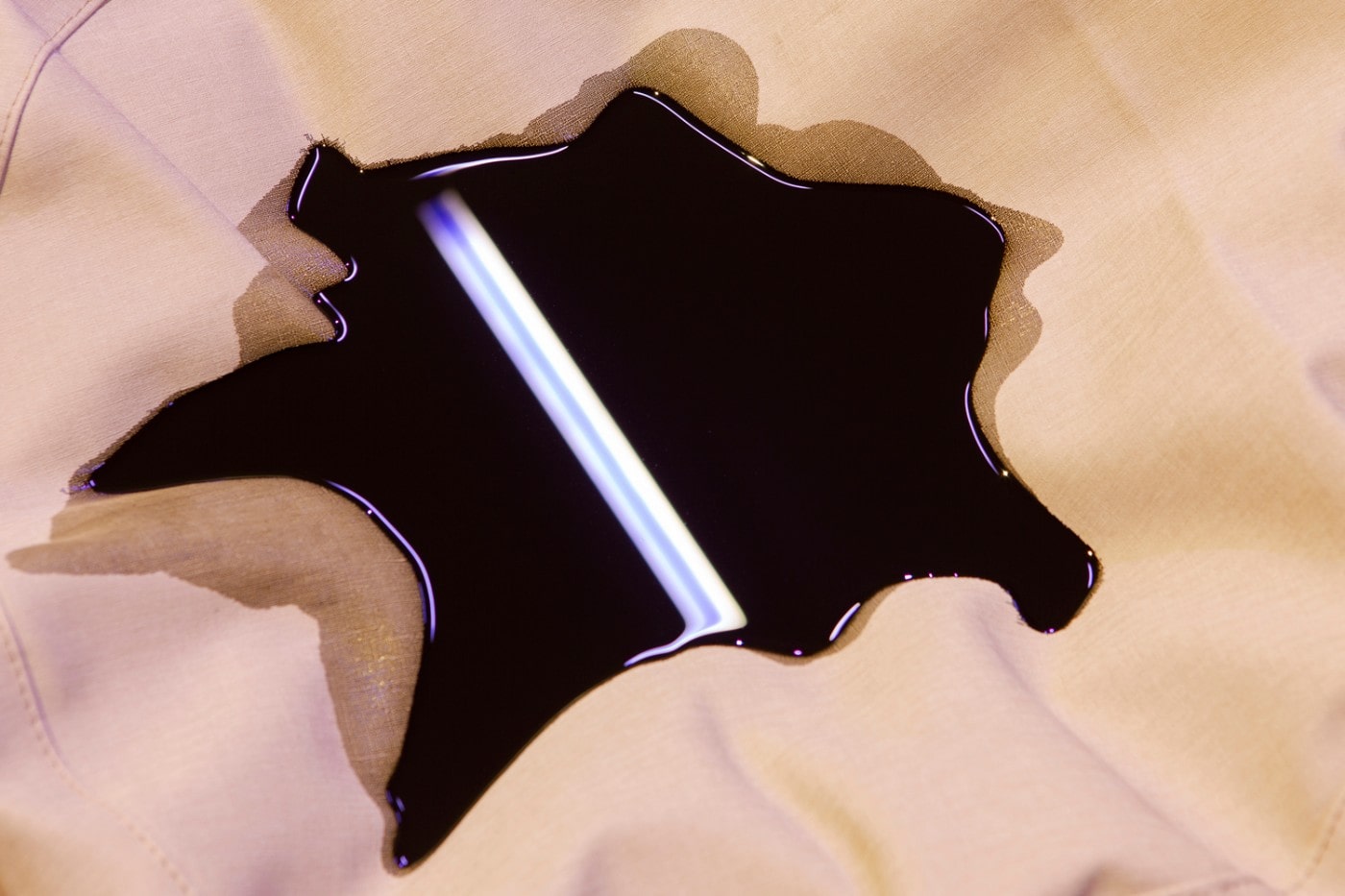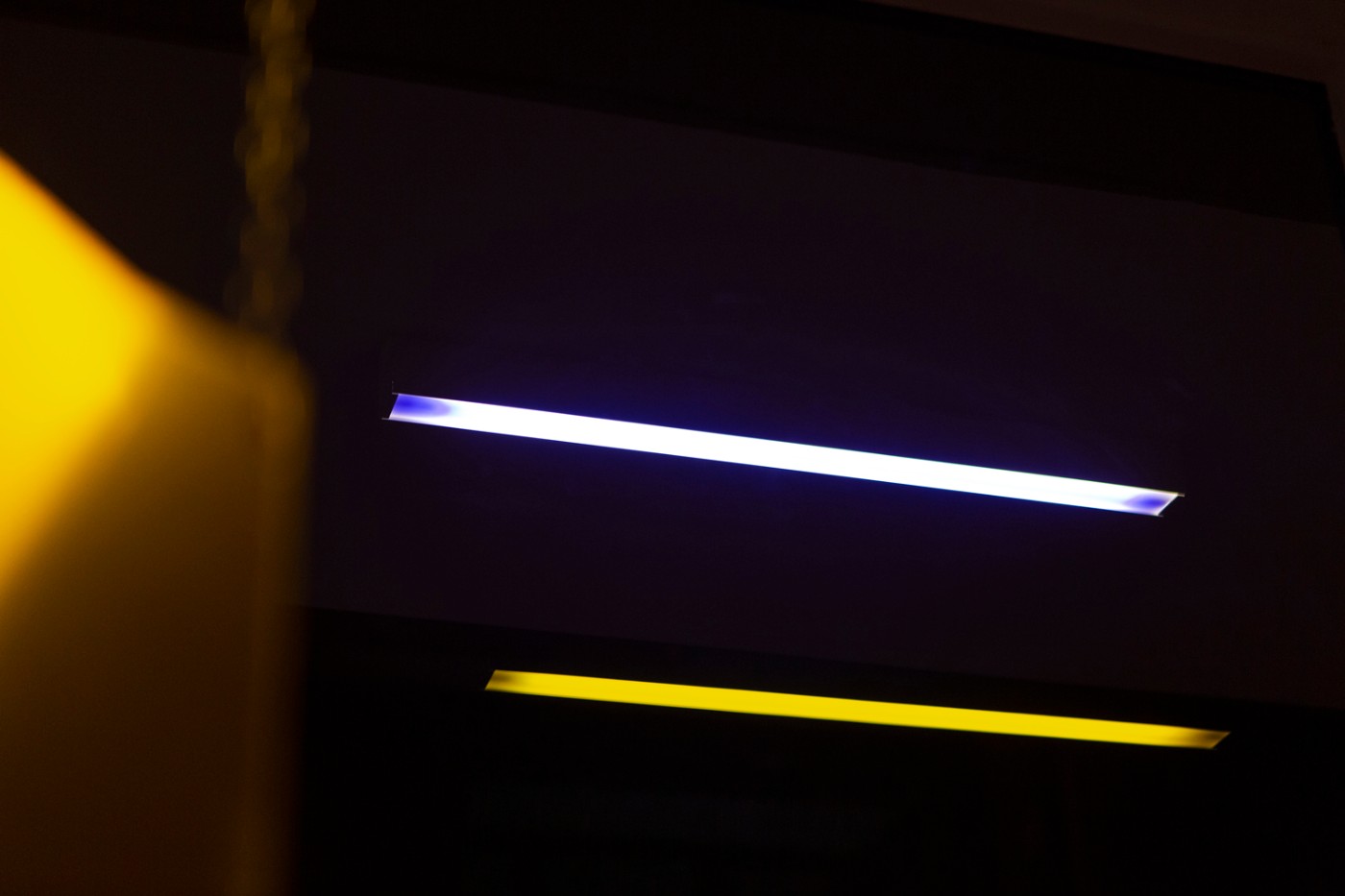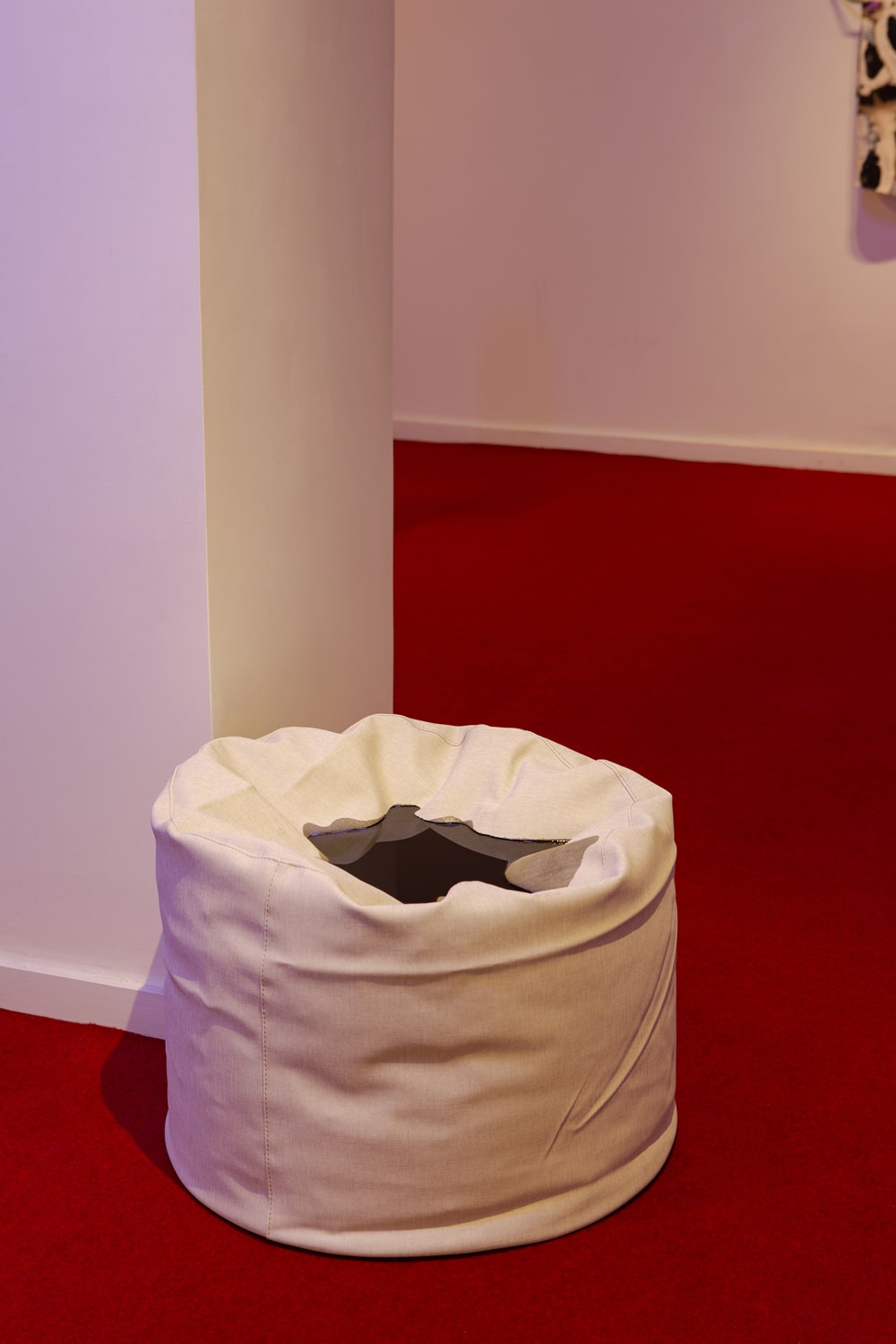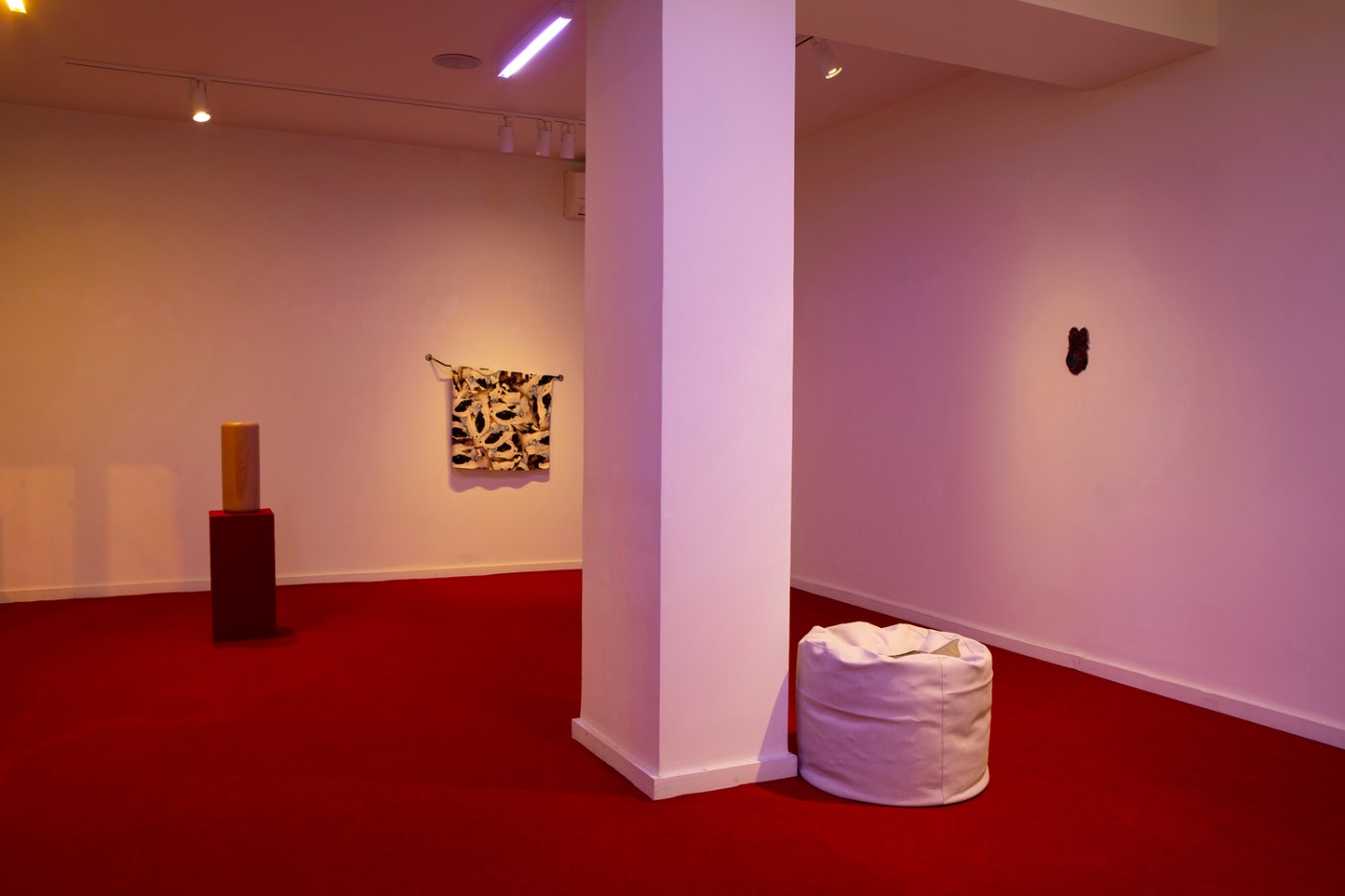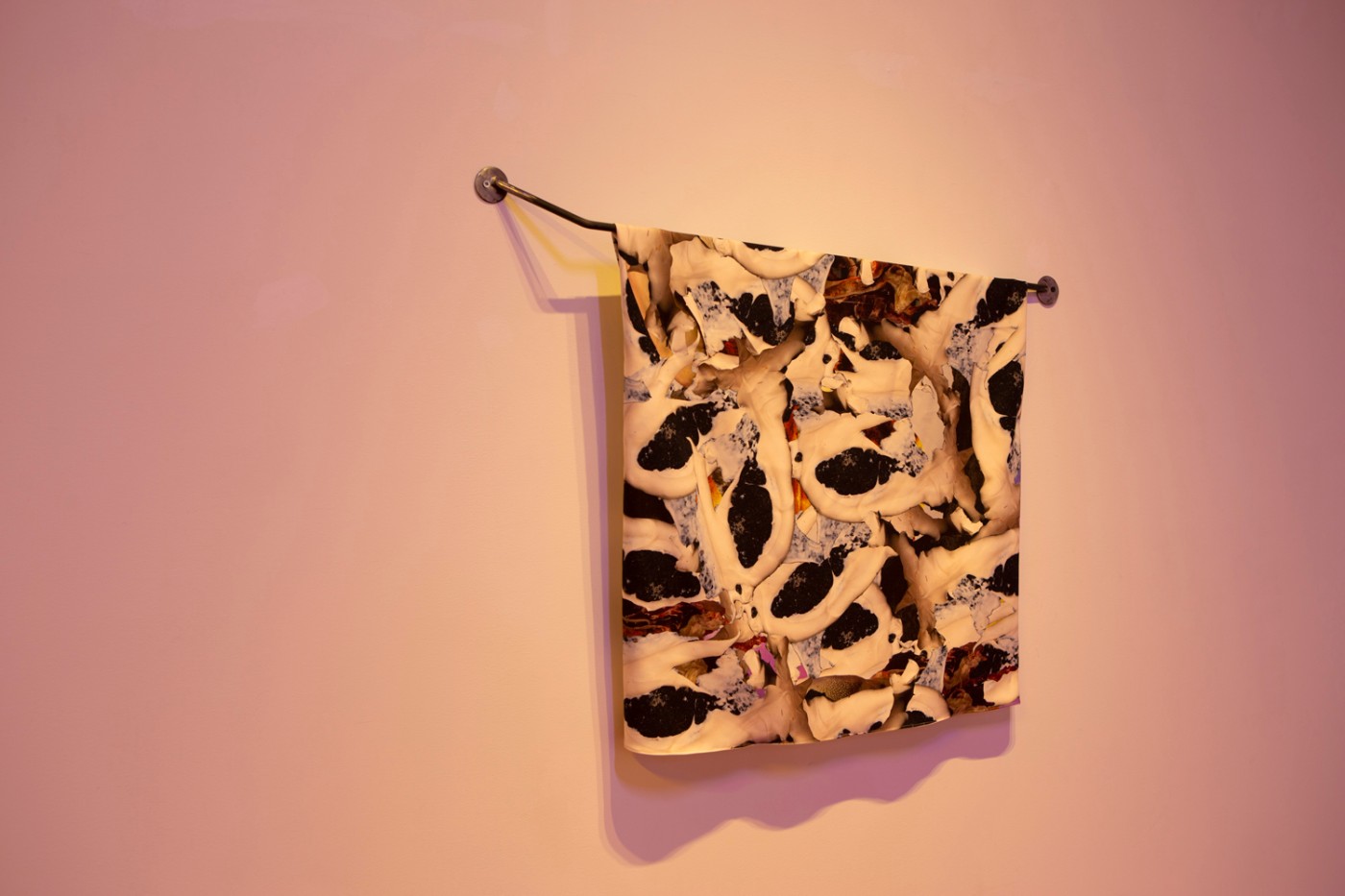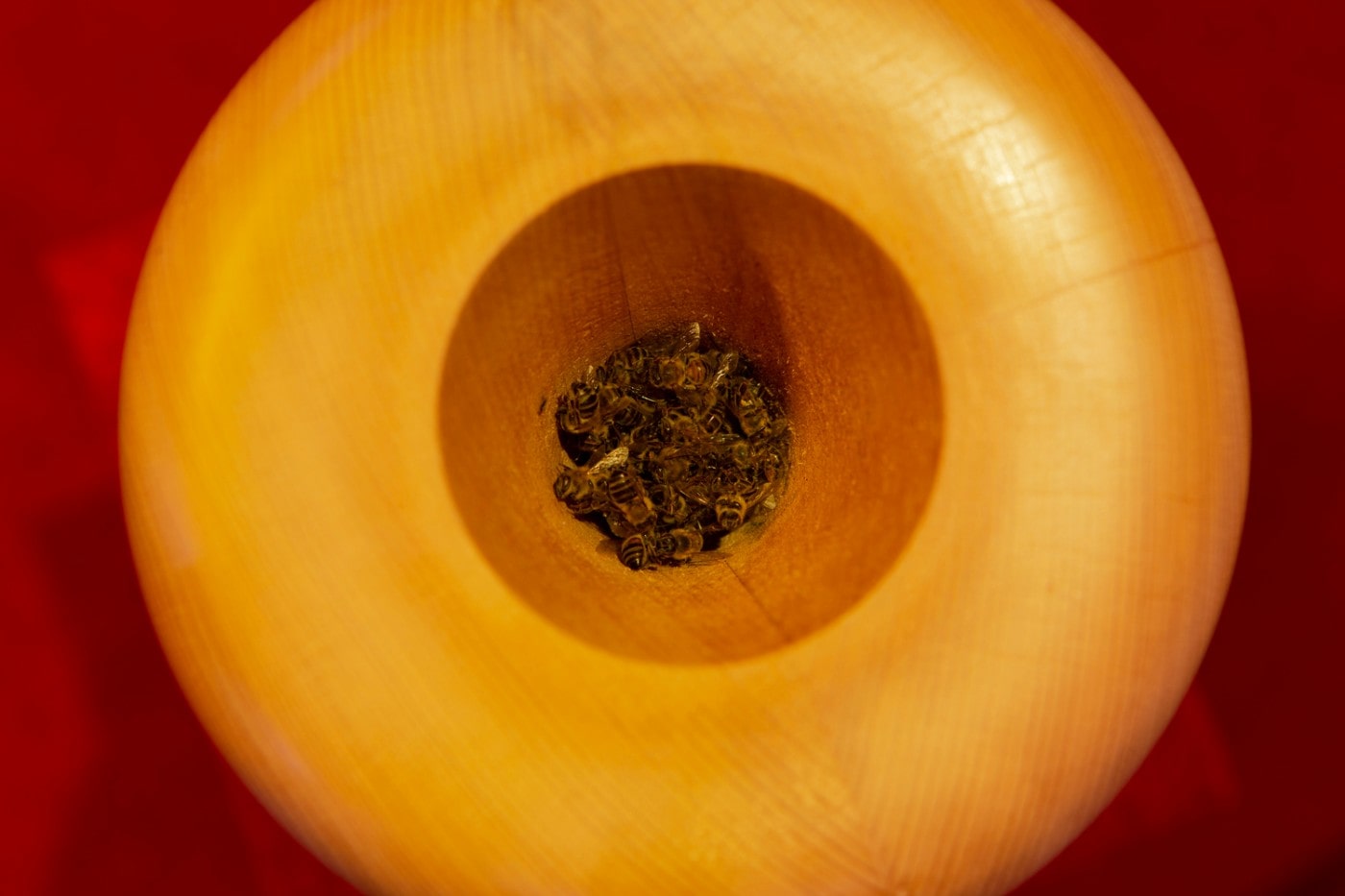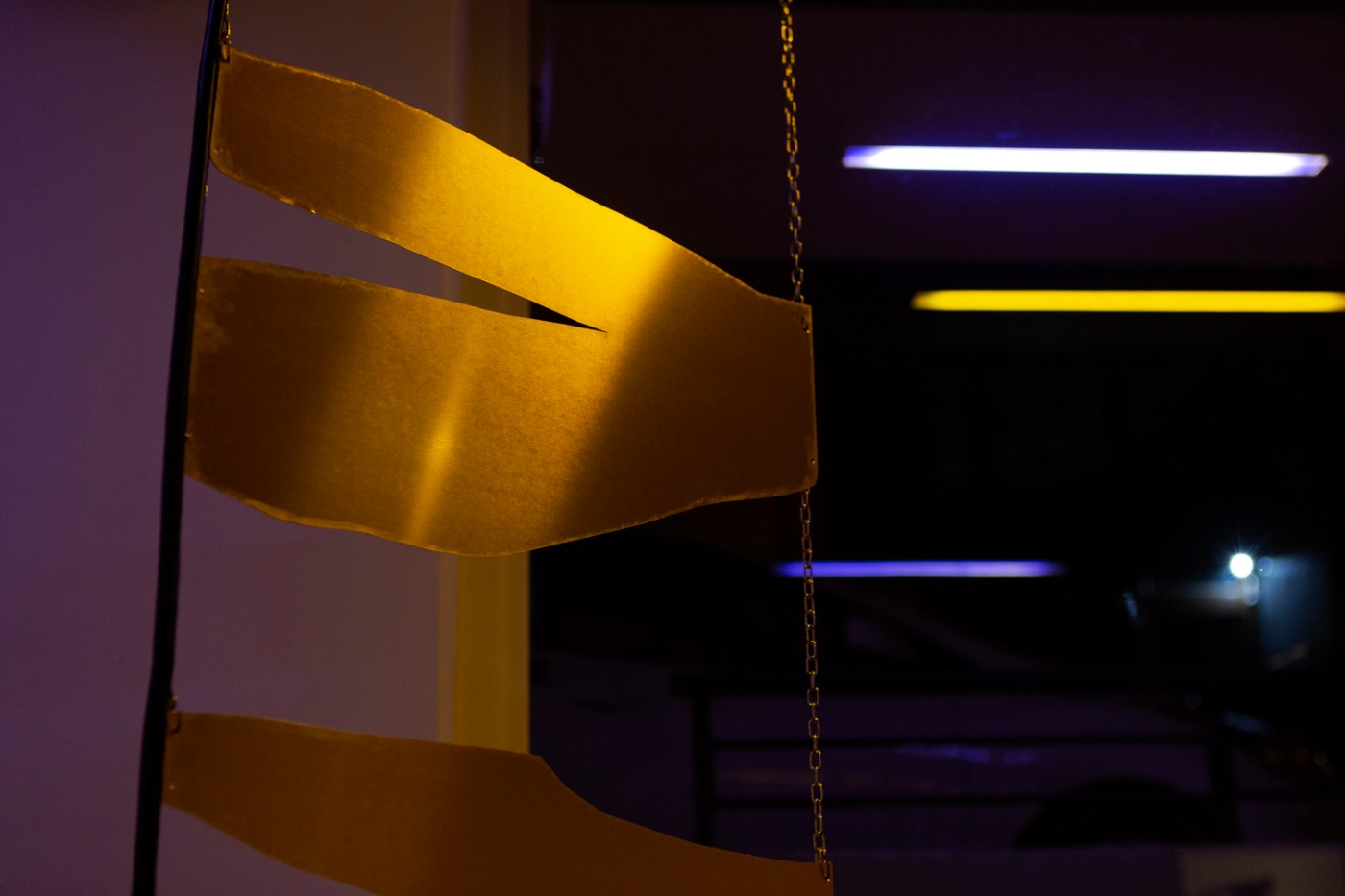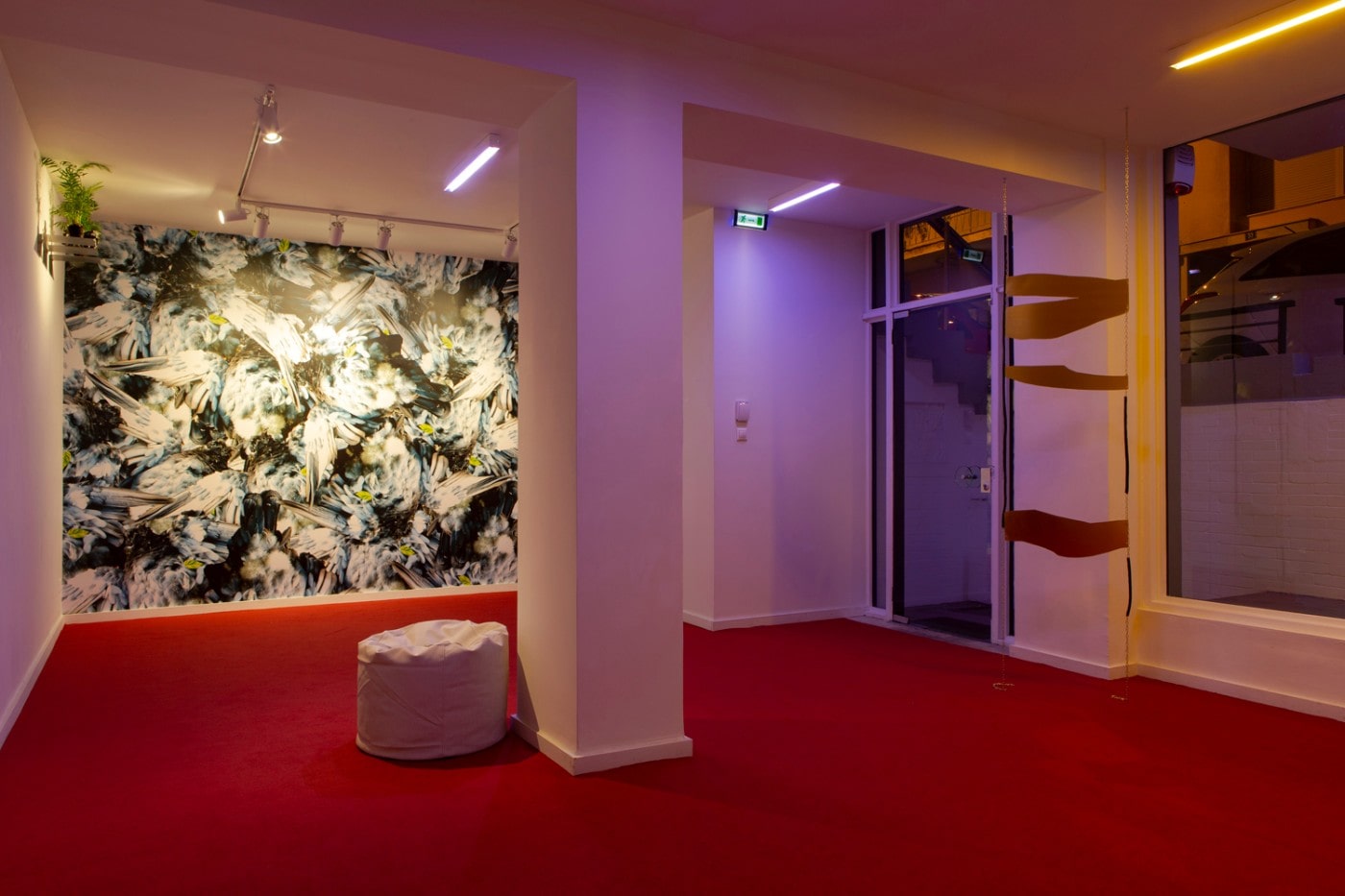For his new solo show at Nitra Gallery Athens, Antwerp-based visual artist Yorgos Maraziotis transforms the entire gallery space into an immersive installation that lures visitors in with softness warmth. The entire space is covered with thick red carpet that muffles sound and creates a sense of domesticity, only reinforced by the suppleness of the fabric used in two of the main artworks, as well as a well-polished wooden cylinder with round edges standing illuminated on a pedestal. The entire installation is dimly lit by a dim, otherworldly light which is the result of a combination of yellow and purple fluorescent lamps installed on the ceiling.
The installation indeed welcomes guests with materials that invite the touch and create a sense of containing safety and relaxation. As soon as visitors set foot on the lush red carpet, they are drawn to the far right wall by a digital print covering its entire surface. It depicts a random photographic pattern of a fluffy, feather-like texture tinted with with blue and some scattered green leaves. Upon closer inspection however, and only after the visitor has been drawn already close to the image, does it become apparent that the fluffy texture is in fact the exposed belly of a dead bird photographed from above. The work is a collage of a photo of the dead animal taken by the artist on a walk. It is from here that the whole experience of the installation takes a completely different turn, exposing its apparent coziness as tainted by the macabre and the untouchable.
As one wanders deeper into the installation is confronted by similar startling revelations: a beige fabric pouf has a puddle of burnt machine oil pressing it down, and the wooden buffed cylinder that begs to be touched is in fact filled with dead bees. Over time, the regal red carpet takes more the colour of blood, and the beautiful bronze mirrors hanging elegantly from the ceiling feel fractured and razor sharp. The nuances of each object, its materiality and the way it interacts with the special lighting are impossible to capture with a camera, and can only be experienced fully in person.
The contrast between sheer violence concealed by domestic comfort relates to the artist's research into how we inhabit the world: in other words, it reveals the violence necessary to domesticate the world in order to make it fit for human habitation. Inevitably, architecture comes into play, especially in the way it creates environments for human living. Maraziotis's installation is in dialogue with the architecture of the space it inhabits, while creating its own internal spatial dynamics. In the following interview, the artist goes into more depth about the inspiration behind the installation and his collaboration with architect Dimitris Theodoropoulos as part of the project.
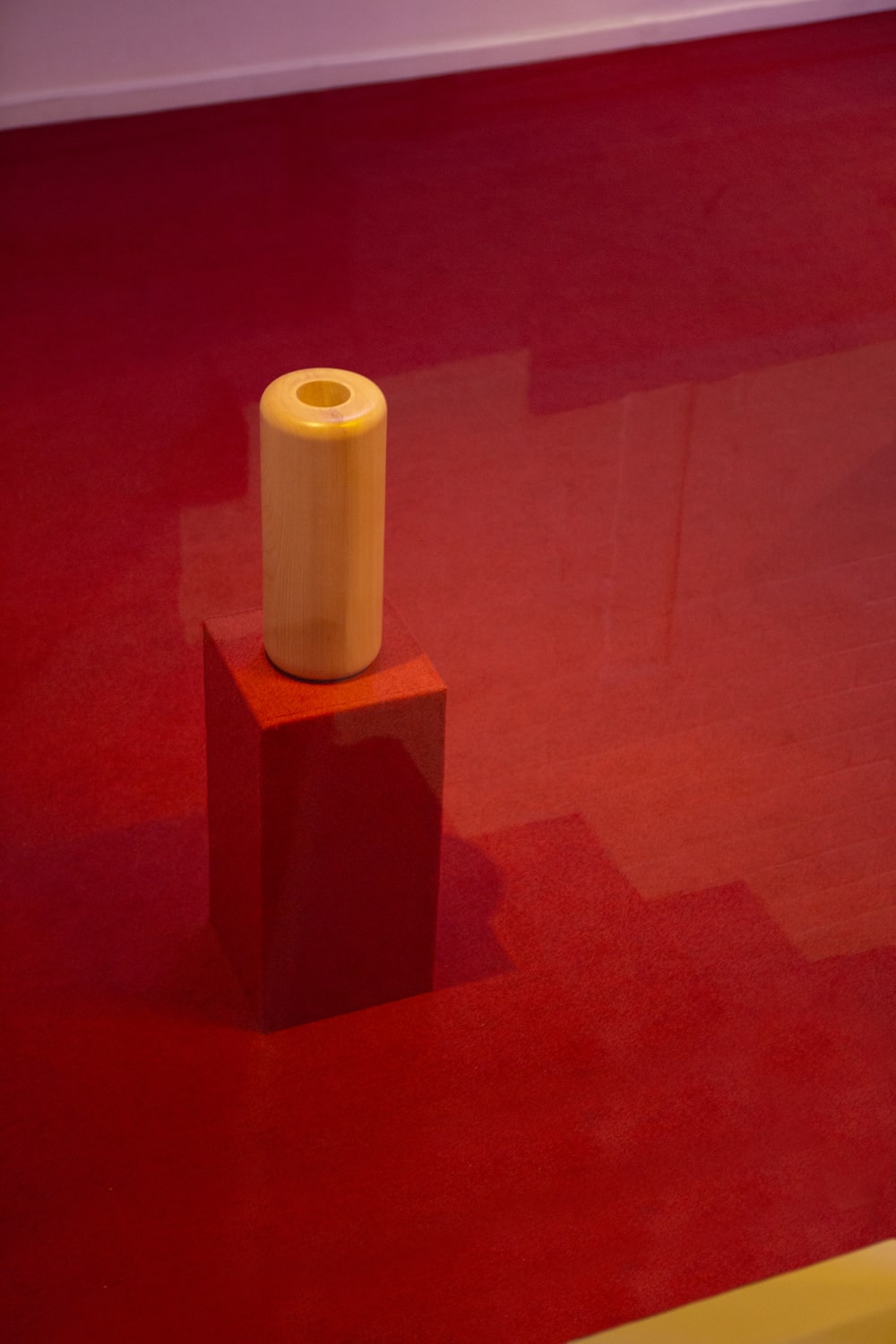
Your practice has evolved from illustration and print to sculpture and working with space. How does your three-dimensional work relate to working in two dimensions?
Well, whenever I start creating a three-dimensional work, I first think and act as a painter or a draughtsman. And while my two-dimensional designs are being developed, I am being intrigued by the possibilities that arise in translating or transforming these designs into works with a three-dimensional body: works that occupy space without being very present. I try to explore this state of things between visibility and invisibility.
Across your work I notice a constant treatment of space through compression. Is this a conscious process for you, and if so, does it relate to or reflect particular ideas behind the work?
Indeed, there is a type of compression or tension that I try to explore through the flatness of my forms or through a repetition of various shapes that I create. I also tend to push the limits of various materials and expose them to situations that make them lose their textures or their surfaces, and surprise the viewers. It is definitely a conscious process and it relates to the notion of misleading or surprising the audience. By altering the perception we have about certain mediums, my works ask their viewers to reconsider their role.
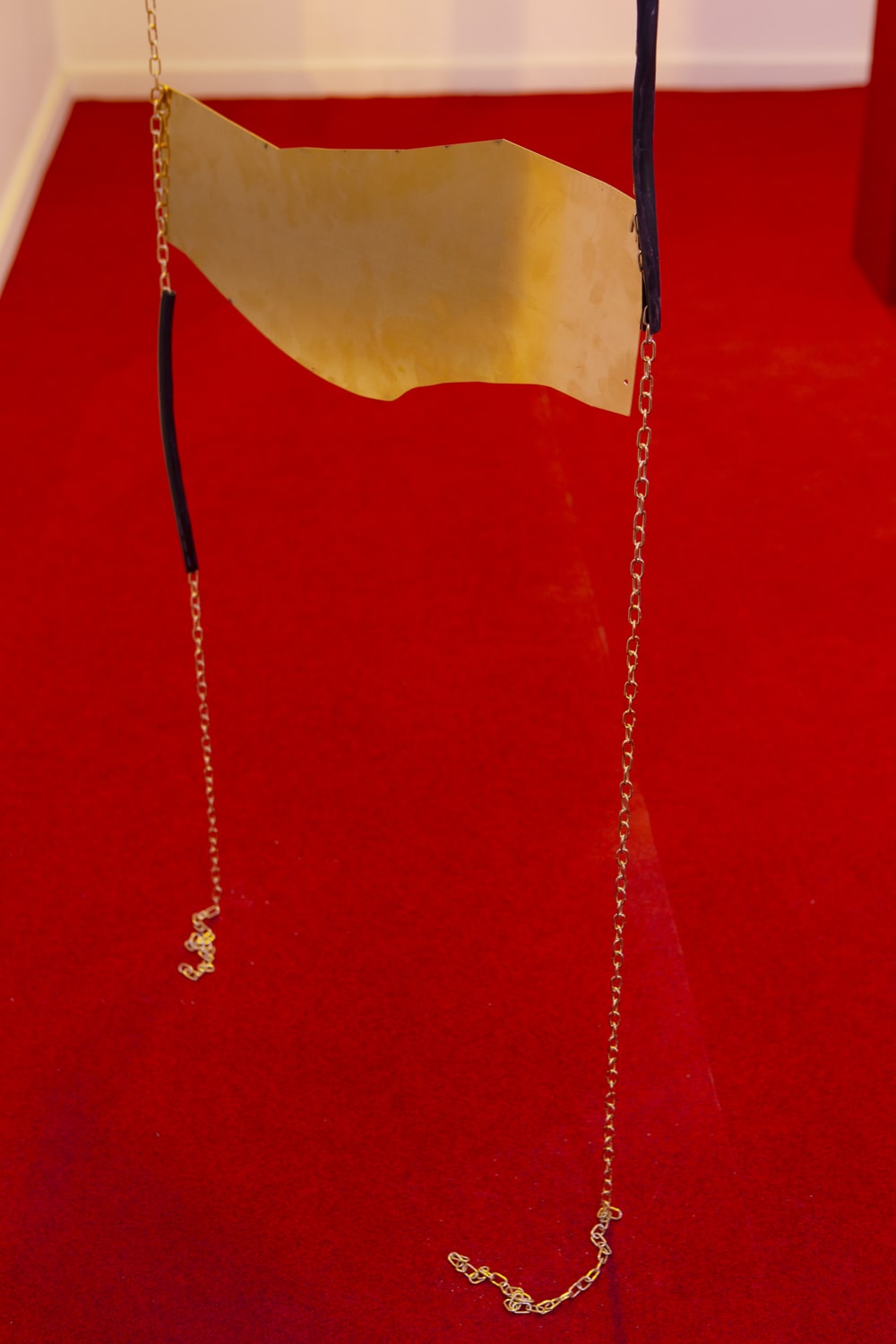
Is Rush Rash Rush your first spatial installation? How do you envision the interaction between space and body in this particular work?
Actually no, my first solo spatial installation was titled 5 Seasons and was presented at the basements of the Old Arsakion School in Patras ten years ago. It was commissioned by the Municipality of Patras and there, in that iconic building, I produced five different landscapes through the usage of sculptures, theatrical lighting and a video. Again the audience was invited to wander around and engage with the combination of natural and artificial mass. Rush Rash Rush is my first solo attempt after that exhibition, much smaller in scale but with definitely a more raw and disturbing context.
What kind of interesting ideas from Heidegger's "Bauen, Wohnen, Denken" have resonated with you as part of this new work?
Heidegger’s work acts as a starting point for my research. My show is not a philological exegesis of the philosopher’s writings. But upon reading Bauen, Wohnen, Denken I realised that the questions he posits on the concept of land, about how with inhabit domestic spaces and how we think of ourselves within a topos, are notions that trouble me a lot and which I'm already trying to address through my practice. Especially the issue of how much we are aware of our body, how we feel our centre—which maybe relates to the centre of the space that we inhabit, historically or even conceptually—is something that triggers my art-making.
Tell us a bit about your collaboration with Dimitris Theodoropoulos, which is part of Rush Rash Rush. Why is dialogue a structural part of a visual art project?
Since last summer that I began developing the work, I wanted to bring someone in with whom I could exchange ideas and beliefs on the notions of space, land and habitation. I thought that collaborating with an individual from a different background than mine could bring an intimate character in the artwork’s becoming. I approached Dimitris not only because of his conceptual architectural practice but also because as a teacher of architectural drawing at the Tinos School of Fine Arts has an interesting relation to sculpture. So, since the beginning of 2019 we have started creating this collaborative work using dialogue and narration. We focus on personal and direct architectural experiences, on gestural behaviours that highlight the sanctity in everyday processes and the role of the body (either human or that of a construction) in contemporary societies. The outcome of this process is still unknown to us; it may for example be that the dialogue itself will become the final artwork. Lacking a typical presentable form is much more interesting to us and it will definitely leave the necessary space needed by the audience in order to participate in its becoming.
